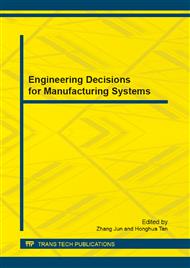[1]
S. Adamczak, W. Makiela et al., Statistical validation of the method for measuring radius variations of components on the machine tool In: Metrology and Measuring Systems Vol. 18, no. 1, pp.35-46, ISSN: 0860-8229, (2011).
DOI: 10.2478/v10178-011-0004-5
Google Scholar
[2]
M. Džupon, M. Gajdoš, J. Jurko, M. Ferdinandy, D. Jakubeczyová, Plastic Deformation Around Holes Drilled in Austenitic Steel 1. 4301. Chemické listy, Vol. 105, (S), pp.606-608, ISSN 0009-2770, (2011).
Google Scholar
[3]
J. Gašparová, J. Šugárová, D. Kalincová, Study of microstructure and formed part wall thicness changes after metal spinning. In Development of mechanical engineering as a tool for the enterprise logistics progress : science report : project CII-PL-0033-01-0506, Poznan University of Technology, ISBN 83-89873-28-1, pp.187-192, (2006).
Google Scholar
[4]
J. Jurko: Verification of surface finish as an indicator of machinability in turning steel X6Cr16Ni10MoTiN, Advanced Materials Research. Vol. 291-294, pp.2987-2990, ISSN 1022-6680, (2011).
DOI: 10.4028/www.scientific.net/amr.291-294.2987
Google Scholar
[5]
J. Jurko: The use of TiAlN coated carbide tool when finish drilling of stainless steel X4Cr17Ni8TiN. Applied Mechanics and Materials, Vol. 39, pp.369-374, ISSN 1660-9336, (2010).
DOI: 10.4028/www.scientific.net/amm.39.369
Google Scholar
[6]
J. Jurko, A. Panda, M. Gajdoš, Study of changes under the machined surface and accompanying phenomena in the cutting zone during drilling of stainless steels with low carbon content. Metalurgia journal, Vol. 50, 2, pp.113-117, ISSN 0543-5846, (2011).
DOI: 10.1109/icacte.2010.5579026
Google Scholar
[7]
J. Jurko and A. Panda: Simulation of accompanying phenomena in the cutting zone during drilling of stainless steels. 3rd International Conference on Advanced Computer Theory and Engineering, Proceedings, Chengdu : 20. -22. August 2010, Vol. 1, pp. V1239-V1243, (2010).
DOI: 10.1109/icacte.2010.5579026
Google Scholar
[8]
J. Jurko: Verification of cutting zone machinability during drilling of austenitic stainless steels, Proceedings of SPIE - The International Society for Optical Engineering, Vol. 7375 H, (2009).
DOI: 10.1117/12.839061
Google Scholar
[9]
W. Liew, B. Ngoi, Y. Lu, Wear characteristics of PCBN tools in the ultra-precision machining of stainless steel at low speeds. Wear, Vol. 254, No. 3-4, pp.265-277, (2003).
DOI: 10.1016/s0043-1648(03)00002-4
Google Scholar
[10]
I. Mrkvica, R. Konderla, M. Faktor: Turning of Inconel 718 by Cemented Carbides. Key Engineering Materials, Vol. 496, pp.138-147, ISSN 1013-9826, (2012).
DOI: 10.4028/www.scientific.net/kem.496.138
Google Scholar
[11]
P. Pokorný, J. Peterka, Š. Václav: Issue of 5 - axis milling. In: TEAM 2011 : Proceedings of the 3rd International Scientific and Expert Conference with simultaneously organised 17th International Scientific Conference CO-MAT-TECH 2011, 19th-21st October 2011, Trnava Slovakia. Slavonski Brod : University of Applied Sciences of Slavonski Brod, ISBN 978-953-55970-4-9, pp.126-130, (2011).
DOI: 10.31410/itema.2019.159
Google Scholar
[12]
T. Zaborowski: Technologia kszaltowania warstwy wierzchniej. Monografia, Gorzow Wlkp., p.99, ISBN 978-83-932166-8-0, (2011).
Google Scholar


